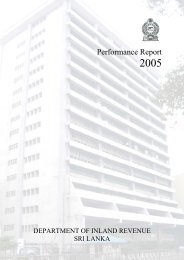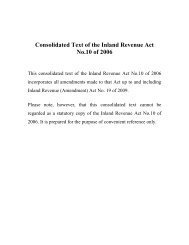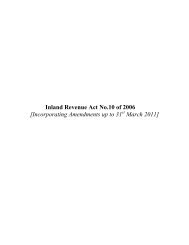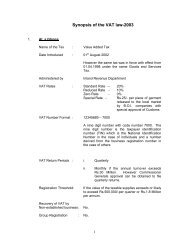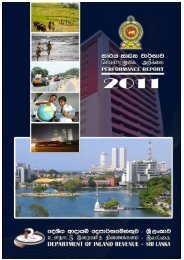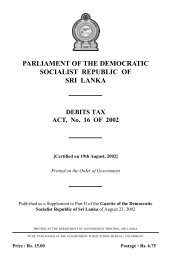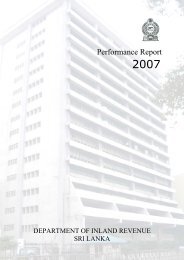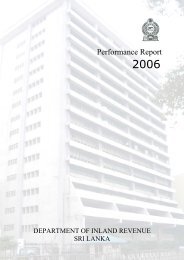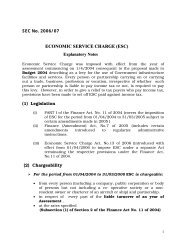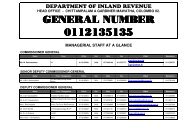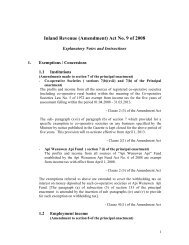VAT Guide to Value Added Tax - sri lanka inland revenue ...
VAT Guide to Value Added Tax - sri lanka inland revenue ...
VAT Guide to Value Added Tax - sri lanka inland revenue ...
Create successful ePaper yourself
Turn your PDF publications into a flip-book with our unique Google optimized e-Paper software.
• Under the existing provisions the finance charges component will be<br />
exempted while the cash price component is liable <strong>to</strong> <strong>VAT</strong>.<br />
• Under the expected clarification both the cash price and finance charges<br />
will be exempted from <strong>VAT</strong> and the company H is no entitled <strong>to</strong> any<br />
input credit on such hire-purchase s<strong>to</strong>cks.<br />
• The tax payers are expected <strong>to</strong> follow the latter method.<br />
Eg.2 - ‘B” is not a registered person for <strong>VAT</strong>. He imports a vehicle for Rs.1,000,000/-<br />
(C.I.F) <strong>VAT</strong> paid <strong>to</strong> cus<strong>to</strong>m is Rs.200,000/-. Thus his <strong>to</strong>tal cost is 1,200,000/-.<br />
He goes in for a hire-purchase with a hire-purchase company “H”.<br />
Transfer of vehicle form B <strong>to</strong> H is a separate supply. But it is not a liable <strong>to</strong> <strong>VAT</strong><br />
because B is not a registered person. Price at which the vehicle will be<br />
transferred is Rs.1,200,000/-<br />
• Supply of the vehicle by H <strong>to</strong> B under a hire-purchase credit sale is another<br />
supply. This is liable <strong>to</strong> <strong>VAT</strong>, Usually the value of supply is 1,200,000/-. But in<br />
this type of situations where the supply is, made <strong>to</strong> the same original owner who<br />
is not entitled <strong>to</strong> input credit an adjustment will be made in respect of uncliamable<br />
input. Sec. 6(5). Vide para 3.8(5)<br />
Thus adjusted value of supply = 1,200,000 – 200,000<br />
= 1,000,000<br />
<strong>VAT</strong> payable @ 20% = 200,000/-<br />
The original owner, who bought the vehicle on hire-purchase terms, must pay<br />
200,000/- as <strong>VAT</strong> <strong>to</strong> the hire-purchase company in addition <strong>to</strong> <strong>VAT</strong> paid<br />
(Rs.200,000) <strong>to</strong> Cus<strong>to</strong>ms. Hire-purchase company H should declare this amount<br />
as output tax.<br />
17.4 Re-possession of goods by the Hire purchase Co.<br />
• If the hire- purchaser defaults payment the hire purchase company has the right<br />
<strong>to</strong> re-posses the goods. The company usually re-sell the goods <strong>to</strong> a 3 rd party and<br />
proceeds are taken in satisfaction of the whole or part of the debt outstanding.<br />
Following supplies can be identified in such a situation.<br />
• Re-possession by the hire-purchase company constitute a separate supply. The<br />
supplier is the defaulting hire-purchaser and the consideration for the supply is<br />
the settlement of the debit. If the hire-- purchaser is a registered person and if<br />
the goods are not exempt he must issue a tax invoice <strong>to</strong> the hire-purchase<br />
company and charge <strong>VAT</strong>. The “value of supply” on which <strong>VAT</strong> is calculated is<br />
the amount of the debt that is settled which is usually the sale price of the asset<br />
99



